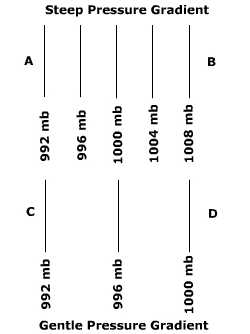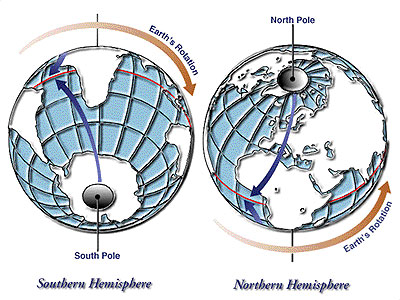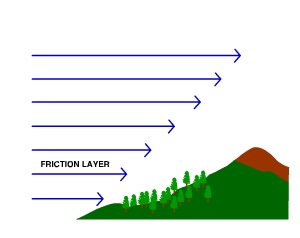
Air is constantly moving to seek an equilibrium between areas of more air molecules (higher pressure) and those with less (lower pressure). You have probably experienced this by opening a container that has been vacuum packed. Because the container is vacuum packed, there is less air inside the can (lower pressure) than outside the can (higher pressure). When you open the container you here a "whoosh" as air rushes into it. The air rushing from the outside to the inside is a wind, albeit at the microscale. Wind is nothing more than the movement of air molecules from one place to the next. The direction and speed of the wind represents the balance between three basic forces acting on it: the pressure gradient, the Coriolis force, and surface friction.

The spacing of isobars indicates the change in pressure over distance otherwise known as a pressure gradient. We can induce a change in pressure over distance by the unequal heating of the Earth's surface. This can be done when one location receives more incoming energy than another, possibly because one place has a higher sun angle than another. Heating the air in one place causes it to rise off the surface promoting low pressure at the surface with the pressure at the surface increasing away from that location. The creation of such a pressure gradient initially causes the air to flow from higher toward lower pressure, creating a wind. So in terms of a cause-and-effect relationship: Energy gradient -> temperature gradient -> pressure gradient -> wind The orientation or direction of a pressure gradient is always described as being from higher toward lower pressure. The speed of the wind is controlled by the strength of the pressure gradient: the stronger the pressure gradient the higher the wind speed. The strength of the pressure gradient can be discerned from the spacing of isobars on a weather map. Figure \(\PageIndex\) shows two different pressure gradients. The distance between points A and B and C and D is the same but the amount of pressure change is quite different. You can tell that the pressure gradient is greater between A and B because the spacing of the isobars is much closer than between C and D. As a result, the wind blows much faster between A and B.

The Coriolis force is the effect of earth rotation on the direction of the wind. The Coriolis force arises for two reasons, first our directional system of latitude and longitude has been fixed to a rotating earth. Thus, our frame of reference for monitoring the direction of a free-moving object above the Earth is constantly changing: the wind goes straight, but we are rotating away from under it. The second reason is the amount of turning about a vertical axis varies from a maximum at the poles and minimum at the equator. This effect makes the coriolis force stronger near the poles than near the equator. Demonstrate this by standing a pencil on end at the north pole and turn the globe. The pencil completes one full rotation. But standing the pencil on end at the equator and rotating the earth yields no rotation about the vertical axis of the pencil. Figure \(\PageIndex<2>\) shows the deflection that a missile experiences when shot from the North Pole towards the Equator. Because the Earth, and the target, has rotated underneath the free-moving missile, it appears that the missile has veered off course (changed direction). Such is the case for winds blowing above the surface. The deflection works the same way for an east-west wind, the path will curve to the right as it moves across the surface. Though the air is deflected to the right of its path in the Northern hemisphere, in the Southern Hemisphere wind is deflected to the left of its path. Why the difference? It all has to do with perspective. Pick up a globe and spin it in a west to east direction. Now look down on it from above the North Pole. It appears to be spinning in counterclockwise direction. Now keep it spinning from west to east, lift the globe over your head and look at it from above the South Pole. It appears to be going in a clockwise direction. (Kind of weird, huh?) What would make the Coriolis force stronger? Faster rotation, especially together with a larger planet! Case in point: Jupiter has enormous coriolis forces because its rotation takes less than 10 hours and its radius is 10 times larger than earth.

The friction imposed on air by mountains, buildings, vegetation and so on mechanically slows the wind and diverts its direction. Generally speaking wind speed increases with height above the surface as the frictional force of surface diminishes with height. The friction layer is the layer of air that is influenced by friction caused by the surface. The friction layer varies in height across the Earth, but for the most part lies within about a kilometer of the surface.

The combined effects of the pressure gradient, Coriolis effect, surface friction is shown in Figure \(\PageIndex<4>\). Recall that air always flows from higher towards lower pressure. Around high pressure systems (H), air is therefore outward from the center. Around low pressure systems (L), air is directed inward toward the center. If pressure gradient was the only force acting on the air, wind would move directly across isobars at a perpedicular angle. Wind instead moves across the isobars at an angle. Because the Coriolis Effect bends the air to the right of its path (i.e. the direction of the pressure gradient) in the Northern hemisphere, air takes on a clockwise flow around highs and counterclockwise around lows. In the Southern hemisphere, air circulates in a counterclockwise fashion around highs and clockwise around lows. Above the "friction layer", only the pressure gradient and Coriolis effect operate on wind. At particular latitudes, the opposing pressure gradient and Coriolis forces can balance one another high in the troposphere above the friction layer. When this occurs, winds tend to blow parallel to isobars. Winds that blow roughly parallel to isobars are called "geostrophic winds". The fast-moving jet streams are a type of geostrophic wind.
4.3: Controls over wind direction and speed is shared under a CC BY-NC-SA 4.0 license and was authored, remixed, and/or curated by LibreTexts.